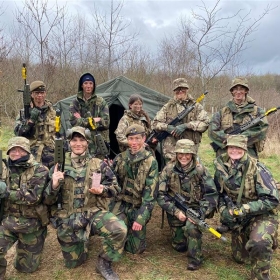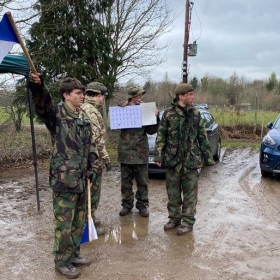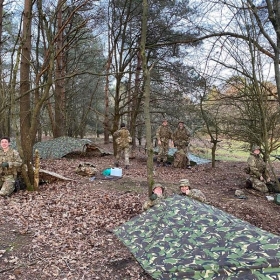Regional 11 SFA Brigade Military Skills Competition 2023
Published by Churcher's College on Friday 31st of March 2023
On a chilly Saturday evening in late March, a section of ten CCF Army cadets (seven from Churcher’s and three from TPS) arrived at Oxney Farm training area near Longmoor Camp to compete in the 11th Brigade Military Skills event.
Directed by the Cadet Training Team (CTT) staff, the cadets set up a cosy harbour area in the pine woodland. Temporary shelters were erected low to the ground and braced between tree trunks with bungee cords to withstand the incoming wet weather that was forecast. Issued with rifles and food, the section then set about cooking up the scrumptious delights of the 24h operational ration packs (ORP) while the wind picked up and tried to extinguish the flame under their mess tins. When the light faded, the cadets took to their sleeping bags and excited chatter died down to get an early night ahead of the next days’ activities. However, around 3am the feint patter of rain intensified into a prolonged heavy downpour and the lost hour of daylight saving was a relief when the 0600 reveille came around.
The Army section was led by Sgt Thomas Dannatt and 2i/c Cpl Oliver Hewett and they organised the bleary-eyed team into frantic action, donning full waterproofs, packing up the soggy camp and a hard routine breakfast (i.e. cold), before being on parade by 0650. With kit checked and assault vest packed with two rifle magazines and ear defenders, the section advanced to the first of seven stands where one-hour scored activities would be conducted throughout the day. The competition began in earnest at 0800 with navigation, which involved a complex mapping task and a test on map symbols and directional procedures. Feeling confident that they had made a good start, but with rain still falling steadily, the section continued to the next stand, the much anticipated ‘Section Attack’.
Blank firing is always a highlight for cadets who enjoy the chance to demonstrate their skills in fire and manoeuvre, working as two fire teams, Charlie and Delta. On arrival at stand two, Sgt Dannatt was briefed by CTT staff while the cadets ‘bombed up’ and then ‘cammed up’, to use the vernacular, in readiness for the attack. For the uninitiated, this means they loaded each of their two magazines with thirty blanks rounds of ammunition and then applied greasy brown and green camouflage cream to their faces as quickly as possible. With no time to practice, the section clicked into stealth mode and advanced along the road in staggered file formation. Turning into the woods, they were met almost immediately by hostile contact from an unseen enemy position over the brow of a brambly ridge. Sgt Dannatt led the Charlie fire-team to the left and returned covering fire, while Cpl Hewett’s Delta team broke right. A billowy, blue-grey haze from a smoke grenade helped to conceal their approach to the target as the fire teams organised into coordinated units of attack. Deftly changing empty magazines and reloading, the cadets proceeded at pace. The enemy was straight ahead, but few in number, and Sgt Dannatt took the brave decision to make a full-frontal assault. Using raucous commands and with deafening rapid fire, the Charlie and Delta fire teams took turns to advance uphill and closer to the enemy position. Once in sight and with the enemy down, the teams swept through the enemy position and formed an all-round defence at the rendez-vous (RV) point beyond. Breathless, Cpl Hewett checked for injuries within the section and the state of ammunition, then Sgt Dannatt gave an evaluative debrief to the CTT staff. The constructive feedback was very positive and Churcher’s were highly commended for the aggressive nature of their direct approach to the target which no other sections had attempted on account of the uneven and uphill terrain. All other units had flanked the enemy position cautiously and taken much longer to neutralise the threat.
Spirits were high as the cadets set off for stand three: Command Tasks. The adrenaline had to subside quickly when faced with a team task requiring focus and a steady hand. The children’s classic buzz wire game was upscaled military-style into a two-metre coil of copper piping spanning the length of a trestle table. It had to be navigated with a hand-held metal loop in under ten minutes without setting off the buzzer, each cadet allowed just one attempt to complete a section. With only a minute to plan, it took four cadets over three minutes to complete the first section. The second section was conquered more easily by a further two cadets, but the final section of piping was made for a left hander. It came down to the final cadet, right-hander LCpl Medley, to complete the final section of the pipe alone. With a cool head and an unwavering grip, he moved the loop with dexterity round tight corners to secure a seven-and-a-half-minute completion time. The second command task, however, was less successful. Using all team members simultaneously, a bucket of tennis balls had to be transferred via three disconnected, plastic drain pipes to another receptacle ten metres away. Using a combination of a short, darts-style throw into the first pipe (LCpl Davies stepped up to the oche), followed by guiding the ball through the next two pipes held by cadets, it was surprisingly difficult to do as the rain continued to fall making the pipes slippery and balls very muddy.
With a gap in the rain, the final stand before lunch was the Patrol Lane. The CTT staff explained the procedure for another blank firing activity in which the section would advance on a location where an enemy parachute regiment had grounded the previous night but were scattered during their descent in a storm. The mission was to gather intelligence before withdrawing to report back to platoon HQ on their observations. The knowledgeable CTT staff shared their considerable battle experience in Afghanistan to explain how to conduct ROC (rehearsal of concept) drills before completing a mission for real. An initial ‘noisy’ rehearsal is where instructions are given loudly by the staff or commanding officer. This is followed by a quiet rehearsal where only hand signals are used to coordinate movement and activities. The cadets were ready.
From a close, herring-bone formation, the cadets moved as a section in single file across open ground and then hugging a hedge-line before pausing to regroup. Entering a dense copse, the unit moved silently into a concealed, prone position to observe enemy activity for several anxious minutes. Inevitably, the cadets came under rapid fire and they returned deliberate fire before an organised, tactical withdrawal, as rehearsed, to a safe position. The wordless communication and execution of the formations was perfect and the cadets were congratulated heartily by staff on their return. The sun emerged briefly for lunch in the field which consisted of whatever was left in the ORP from the night before, heated - for those who had remembered to bring their mess tins and stoves.
The afternoon began with the CASEVAC (casualty evacuation) stand where cadets worked as a team to prioritise casualties, administer first aid and evacuate the injured. The first scenario saw the section arriving back to injured comrades in their own wooded harbour area following a drone strike. The chaos that ensued was amplified by the screams of agony of the acting CTT staff and smoke from a grenade to conceal the cadets from further assault. The section acted quickly to patch up and extract a casualty with a belly shrapnel wound, as well as another with a broken leg and pelvis, but the third didn’t make it, despite the valiant efforts by cadets to administer CPR. The second scenario was set in a minefield and cadets were tasked to extract casualties to a helicopter rescue RV. The cadets were more coordinated this time after constructive feedback from the first attempt, and they rapidly assessed and
prioritised the injured effectively. The CTT injected realism into the activity: Sgt Dannatt was ‘hit’ by enemy fire and the 2i/c had to take over to extract him as well. At the RV rescue point a further cadet ‘casualty’ was sustained in the all-round defence before the end of the activity was called when the bandages were all gone.
The final two stands tested short range shooting and communication. The Scorpion Air Rifle stand was a scored shot at a range of approximately 10m. Between sharp showers and in pairs, cadets took turns to fire five prone and five kneeling shots, while their partner spotted using binoculars. With no time limit and applying the taught principles of marksmanship, half the Churcher’s cadets (Sgt Dannatt, Cpl Hewett, LCpl McBride, LCpl Medley and LCpl Davies) gained the maximum score with all ten pellets hitting the centre of the target – a very impressive record.
The signals exercise comprised a complex combination of relaying messages using semaphore (harder than it looks), morse code (easier than it looks) and assembling and using a military radio. LCpl Gay worked with focus to decipher the codes and LCpl Hill and Cdt Liedtke ably interpreted the semaphore from a distance. Assembly of the radio seemed intuitive for LCpl Cunliffe and excellent team work was demonstrated within and between the groups.
The long day ended with an hour of oily weapon cleaning under the close scrutiny of the CCT staff and once rifles were inspected and returned, there was just the short drive back to school to unload all the sopping wet bashas from the night before. Without exception, the cadets showed endless energy and enthusiasm throughout the competition, full commitment to each of the activities, as well as resilience and good-humour in the face of inclement weather and challenging tasks. Our thanks must go to the 11th Brigade CTT for organising such an enjoyable event for cadets to demonstrate and test their skills.




